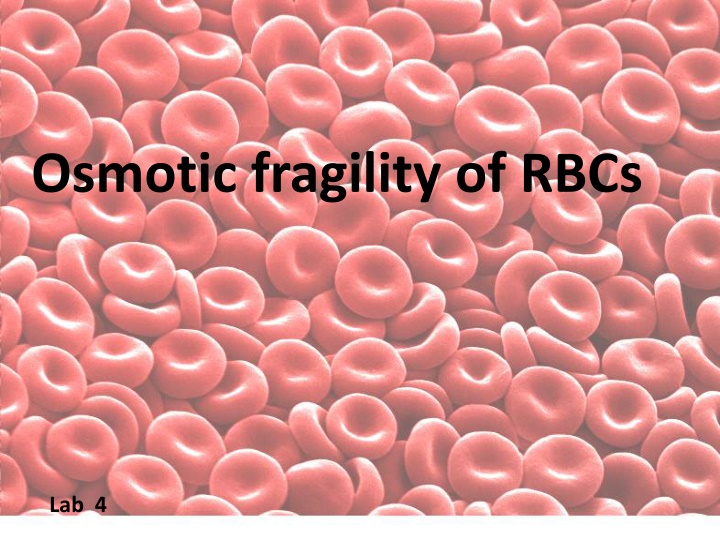Osmotic Fragility Test in Hematology
Osmotic fragility test, a common procedure in hematology, measures red blood cell resistance to hemolysis under varying saline solution dilutions. It aids in diagnosing RBC membrane abnormalities and diseases like thalassemia and spherocytosis. The test involves subjecting RBCs to osmotic stress by placing them in a hypotonic solution, revealing valuable insights into various blood disorders.
Download Presentation

Please find below an Image/Link to download the presentation.
The content on the website is provided AS IS for your information and personal use only. It may not be sold, licensed, or shared on other websites without obtaining consent from the author.If you encounter any issues during the download, it is possible that the publisher has removed the file from their server.
You are allowed to download the files provided on this website for personal or commercial use, subject to the condition that they are used lawfully. All files are the property of their respective owners.
The content on the website is provided AS IS for your information and personal use only. It may not be sold, licensed, or shared on other websites without obtaining consent from the author.
E N D
Presentation Transcript
What is osmosis? a process by which molecules of a solvent tend to pass through a semi-permeable membrane from a less concentrated solution into a more concentrated one.
Osmotic fragility of RBCs The osmotic fragility test (OFT) is used to measure erythrocyte resistance to hemolysis while being exposed to varying levels of dilution of a saline solution. Its performed when a sample of red blood cells are subjected to osmotic stress by being placed in a hypotonic solution.
The osmotic fragility test is common in hematology, and is often performed to aid with diagnosis of diseases associated with RBC membrane abnormalities. Some diseases linked to increased OF include hereditary spherocytosis and hypernatremia, while some linked to decreased OF include chronic liver disease, iron deficiency anemia, thalassemia, hyponatremia, polycythemia vera, and sickle cell anemia after splenectomy.
hypotonic and hypertonic solutions Hypotonic Solution: A hypotonic solution is a water that is less-concentrated than the cell the water surrounds. Because of this, the cell's semi-permeable membrane (the membrane that allows water to enter the cell) allows more water to enter the cell as it attempts to even out the solute(a substance that is dissolved in a liquid). This causes the cell to swell with water, and if it's not stopped, it will burst! Hypertonic Solution: A hypertonic solution is basically the opposite of a hypotonic solution. In this case, the water has more of a solute than the cell does. In this case, water rushes out of the cell in order to maintain equilibrium (equal amounts of solute and water on either side). The cell dries out as it loses water, and it eventually dies.
Why do we do this test? Doctors may order osmotic fragility tests for infants with a family history of thalassemia or hereditary spherocytosis. This can be a fast and cost-effective way to help diagnose the disease. The osmotic fragility test may also be used to help confirm if thalassemia or spherocytosis is the cause of anemia. Symptoms of anemia can include: 1. fatigue 2. shortness of breath 3. dizziness 4. palpitations 5. decreased ability to exercise
What if your test is positive? If your cells are diagnosed as fragile, you most likely have hereditary spherocytosis or thalassemia. Both of these genetic conditions can cause hemolytic anemia. This is a form of anemia that occurs because your red blood cells are destroyed too quickly.























